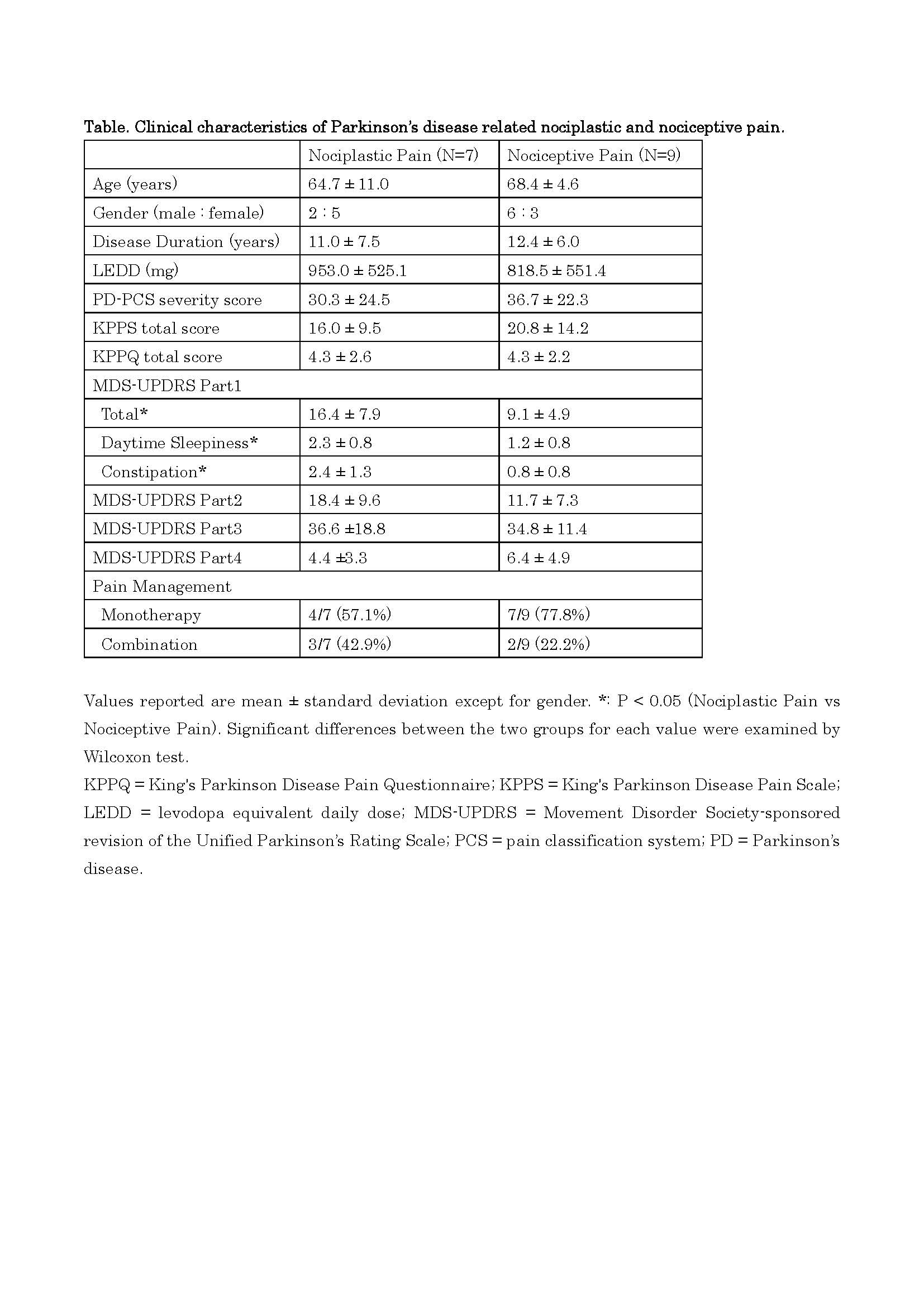Category: Parkinson's Disease: Non-Motor Symptoms
Objective: The characteristics of Parkinson’s disease (PD)-related nociplastic pain were evaluated by using various indicators including PD pain classification system (PD-PCS), King’s Parkinson Disease Pain Scale (KPPS) and King’s Parkinson Disease Pain Questionnaire (KPPQ).
Background: PD-PCS proposed by Mylius was a framework to differentiate PD- from non-PD-related pain and classify PD-related pain into 3 categories (nociceptive, neuropathic, or nociplastic). Nociplastic pain was described as a unique type of PD-related pain where the nociceptive system is overactive without any evidence of somatosensory system lesion or peripheral activation of nociceptors. To date, there have been few studies on nociplastic pain in PD.
Method: By using PD-PCS, we categorized pain of PD patients into PD-related or non-PD-related pain. PD patients who clearly had other causes of pain were excluded. To detect the characteristics of nociplastic pain, we investigated various scales (MDS-UPDRS, KPPS and KPPQ) and the pain managements (analgesics for nociceptive pain, anticonvulsants for neuropathic or dystonic pain, and anit-PD medications including adjusting deep brain stimulation).
Results: Twenty PD patients (age 67.8±7.6 years, disease duration 11.9±6.3 years) were recruited. PD-related pain was present in 18 patients (90%). Nociceptive, neuropathic, or nociplastic pain was diagnosed in 9 (45%), 2 (10%), or 7 (35%), respectively. Between the nociplastic and nociceptive pain group, there were no significant differences in the age, disease duration, levodopa equivalent daily dose, UPDRS Part 2-4 and KPPQ total scores. On the other hand, UPDRS Part1 scores were significantly higher in the nociplatstic pain group than in the nociceptive pain group (p = 0.017, Wilcoxon test). In UPDRS Part1, the scores of daytime sleepiness (p = 0.025) and constipation (p = 0.014) were significantly higher in the nociplastic group. While PD-PCS severity score and KPPS tended to be lower in the nociplastic pain group than in the nociceptive pain group, the combination of pain managements was more common in nociplastic pain (nociplastic: 42.9%, nociceptive: 22.2%).
Conclusion: Nociplastic pain is not rare type among PD-related pain. It may be influenced by PD-related non-motor symptoms, tend to be milder than nociceptive pain, but be treated by the combination of pain managements.
References: [1] Mylius V, Perez Lloret S, Cury RG, Teixeira MJ, Barbosa VR, Barbosa ER, Moreira LI, Listik C, Fernandes AM, de Lacerda Veiga D, Barbour J, Hollenstein N, Oechsner M, Walch J, Brugger F, Hägele-Link S, Beer S, Rizos A, Chaudhuri KR, Bouhassira D, Lefaucheur JP, Timmermann L, Gonzenbach R, Kägi G, Möller JC, Ciampi de Andrade D. The Parkinson disease pain classification system: results from an international mechanism-based classification approach. Pain. 2021 Apr 1;162(4):1201-1210. doi: 10.1097/j.pain.0000000000002107.
[2] Kurihara K, Fujioka S, Mishima T, Konno T, Seki M, Tsuboi Y. Japanese translation and linguistic validation of King’s Parkinson’s Disease Pain Scale (KPPS) and King’s Parkinson’s Disease Pain Questionnaire (KPPQ). Rinsho Shinkeigaku. 2022 Jan 28;62(1):15-21. doi: 10.5692/clinicalneurol.cn-001686. Epub 2021 Dec 18.
To cite this abstract in AMA style:
T. Tezuka, T. Nukariya, S. Okusa, Y. Nihei, J. Nakahara, M. Seki. The characterization of Parkinson’s disease related nociplastic pain based on the classification system [abstract]. Mov Disord. 2023; 38 (suppl 1). https://www.mdsabstracts.org/abstract/the-characterization-of-parkinsons-disease-related-nociplastic-pain-based-on-the-classification-system/. Accessed January 4, 2026.« Back to 2023 International Congress
MDS Abstracts - https://www.mdsabstracts.org/abstract/the-characterization-of-parkinsons-disease-related-nociplastic-pain-based-on-the-classification-system/

